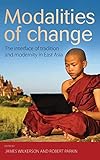Modalities of Change : The Interface of Tradition and Modernity in East Asia / ed. by Robert Parkin, James Wilkerson.
Material type: TextPublisher: New York ; Oxford : Berghahn Books, [2012]Copyright date: ©2012Description: 1 online resource (262 p.)Content type:
TextPublisher: New York ; Oxford : Berghahn Books, [2012]Copyright date: ©2012Description: 1 online resource (262 p.)Content type: - 9780857455680
- 9780857455710
- online - DeGruyter
| Item type | Current library | Call number | URL | Status | Notes | Barcode | |
|---|---|---|---|---|---|---|---|
 eBook
eBook
|
Biblioteca "Angelicum" Pont. Univ. S.Tommaso d'Aquino Nuvola online | online - DeGruyter (Browse shelf(Opens below)) | Online access | Not for loan (Accesso limitato) | Accesso per gli utenti autorizzati / Access for authorized users | (dgr)9780857455710 |
Frontmatter -- Contents -- List of Figures, Tables and Diagrams -- Preface -- Introduction. Modalities of Change: The Interface of Tradition and Modernity in East Asia -- People’s Republic of China -- Chapter 1 The House, the State and Change: The Modernity of Sichuan RGyalrong Tibetans -- Chapter 2 From Kinship to State and Back Again: Lineage and History in a Qiang Village -- Chapter 3 Embroidery Speaks: What Does Miao Embroidery Tell Us? -- Chapter 4 Tensions between Romantic Love and Marriage: Performing ‘Miao Cultural Individuality’ in an Upland Miao Love-Song -- Chapter 5 Modalities of the One-Child Policy among Urban Migrants in China -- Chapter 6 The ‘Culture’ of World Cultural Heritage -- Taiwan and Vietnam -- Chapter 7 ‘Amis Hip-Hop’: The Bodily Expressions of Contemporary Young Amis in Taiwan -- Chapter 8 Contesting Memory: The Shifting Power of Narration in Contemporary Paiwan Contexts -- Chapter 9 Ethnicity as Strategy: Taiwan State Policies and the Thao -- Chapter 10 On the ‘Third Morning’: The Continuity of Life from Past to Present among the Nung of Northern Vietnam -- Afterword: Performance as a Mechanism for Social Change -- Notes on Contributors -- Index
restricted access online access with authorization star
http://purl.org/coar/access_right/c_16ec
While in some cases modernity may dominate 'traditional' forms of expression, in others, the modern is embraced as a welcome source of new ideas that can modify 'tradition' while still keeping it within its own bounds. Maintaining a strong and distinct cultural identity with the help of modernity helps representatives of that identity cope with the modern world more generally. By contrast, assimilation to a dominant culture marked as modern is clearly associated with not only the loss of a distinct identity, but also its specific forms of cultural expression. This book explores the consequences of the interface between modernity and tradition in selected societies in Taiwan, mainland China and Vietnam. The contributors examine how traditions are themselves exploiting modernity in creative ways, in the interests of their own further cultural developments, and to what extent this approach is likely to help a tradition survive.
Mode of access: Internet via World Wide Web.
In English.
Description based on online resource; title from PDF title page (publisher's Web site, viewed 25. Jun 2024)


